Contents
If you’ve ever touched a hard drive (either internal or external) after it’s been running for some time, you’ve probably noticed that it’s quite warm. Being a mechanical component, we would expect a hard drive to generate some heat during normal operation. Like most computer components, however, the hard drive is susceptible to damage should it be allowed to run at extreme temperatures for an extended period of time. As a long-time data-hoarder with dozens of hard drives, I’ve become accustomed to the fact that hard drives can feel hot to the touch and that most of the time it’s nothing to worry about. For people new to data-hoarding, or even just casual PC users, however, it’s often not clear whether or not their hard drive is running too hot and potentially being damaged. To clear up a few questions I’ve seen posted on the various data-hoarding forums recently about hard drive temperatures, I thought I would write this post. Hopefully, it will either put your mind at ease or guide you in lowering your drive’s temperature.
What’s the safe maximum temperature of a hard drive?
Before we can confidently say that a drive is running too hot or not, we need to understand its design characteristics. Some drives are designed to operate at relatively high temperatures quite comfortably, while others need to be kept cool.
Fortunately, the vast majority of hard drive manufacturers publish technical specifications or data sheets on the Internet, free for anyone to access. The recommended temperature limits should form part of these specifications so we can be confident we’re running our drives within the temperature range they were designed for.
Finding the model number of your hard drive
Before looking up the specifications of your hard drive, you need to know its make and model. If you’re a data-hoarder or PC enthusiast then you’ll probably have this information on the tip of your tongue. If you are a mere mortal then don’t worry, it’s easy enough to find the make and model of your hard drive in both Windows and Linux.
If you’re running Windows, I find the easiest way to get your hard drive’s manufacturer and model number is by using PowerShell. PowerShell is included with Windows so there’s nothing extra you need to download. The command we need to use is just a simple one-liner too.
So, launch PowerShell and type “Get-PhysicalDisk | Select-Object Manufacturer, Model”, then press “Enter”.
You should find that PowerShell returns both the disk’s manufacturer and model as shown below:

If you’re running Linux, rather than Windows, then the procedure to find your drive’s model number is slightly different, as you would expect. It’s still easy enough though.
The command is “hdrarm -I <part to device>”. In my case, the hard drive I’m interested in is /dev/sdb so I issue the command “hdparm -I /dev/sdb”.
As you can see in the image below, we now have the hard drive’s model number.
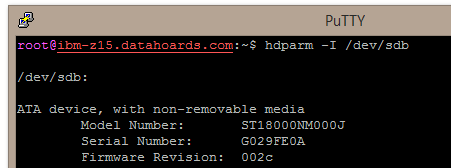
Now that we’re happy that we have the drive’s details, we can go online and look up the drive’s recommended operating temperature. As you’ve seen, the drive I’m working with today is an 18TB Seagate EXOS, with a model/manufacturer part number of ST18000NM000J.
Let’s simply Google the phrase “ST18000NM000J datasheet” and see what results we get.

Excellent. As you can see, the first result is an official PDF document from Seagate that looks like it’s going to provide us with what we’re looking for.
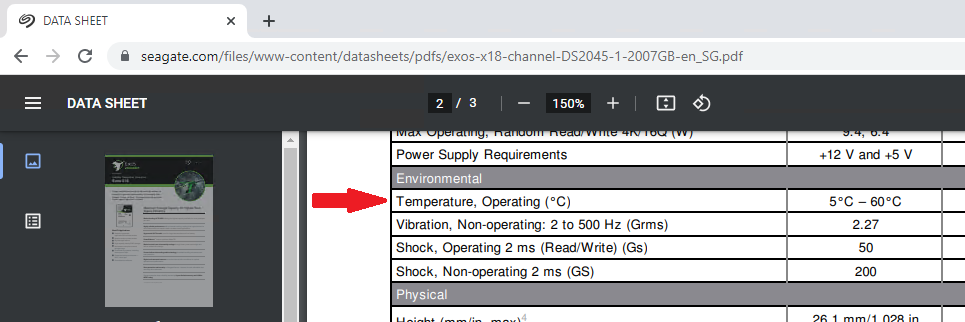
Sure enough, right there on page two is what we need, the operating temperature range. In this instance, we’re told that the drive’s maximum operating temperature is 60 degrees Celcius.
How to check your hard drive’s temperature
At this stage, we know the make and model of our hard drive and we know how hot it is allowed to run, according to the manufacturer. Although you suspect your drive is too hot, the logical step now is to actually measure it and see how the temperature compares to the official guidance.
Check drive temperature under Windows
Under Windows, we’re again going to make use of the inbuilt PowerShell commands. Make sure you launch PowerShell with administrative privileges (right-click on the PowerShell icon and select “Run As Administrator”). This is needed as Windows only provides the disk’s temperature reading to computer administrators, not regular users.
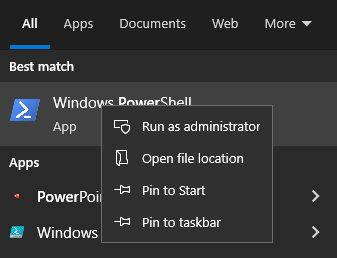
The PowerShell command you need to type or paste is “Get-PhysicalDisk | Get-StorageReliabilityCounter | Format-List Temperature”, then press “Enter”.
You should see PowerShell returns the hard drive’s current temperature, as seen below:

PowerShell has told us that the disk is currently running at 44 degrees Celsius. We know from the manufacturer’s datasheet that the drive is rated to operate at up to 60 degrees so, in this instance, we’re well within thermal design limits.
Check drive temperature under Linux
If you’re running Linux then don’t worry, we’re also going to cover finding your disk’s current temperature so don’t feel like a second-class citizen just for running the “Free” operating system. As I’ve mentioned before, I’m running Debian myself so you’re in good company!
There’s no way to directly access the hard drive’s temperature under Linux. Instead, we must query the disk’s SMART interface to get this information. My tool of choice is “smartctl”. Not only does smartctl let me query the drive’s temperature, it lets me access a whole host of SMART information that’s really useful.
Most Linux distributions don’t ship with smartctl installed so if you’ve not used it before, you might need to install it. Fortunately, under Debian (and Debian-based distros like Ubuntu, Mint, etc), it’s an easy process.
Update your repositories
Simply run “apt update” and wait for it to complete, you should see a similar output to that shown below.
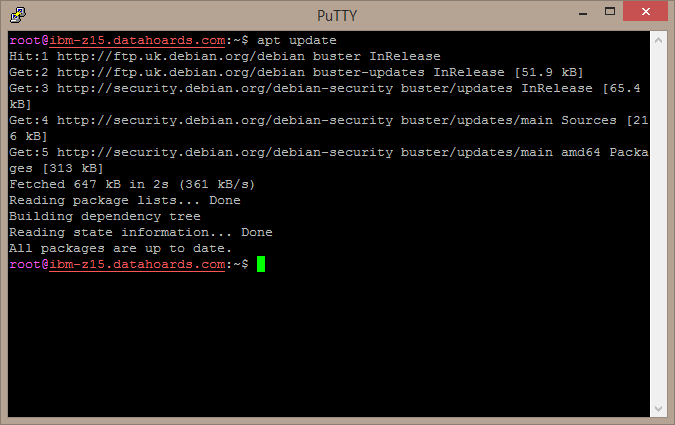
Upgrade your existing packages
You could technically skip this step but it’s good practice and something I always preach so, I’ll include it here. If you’re Linux guru and know better than me then feel free to skip over this. I won’t be offended.
Run “apt upgrade” and wait for the process to finish. Again, you should see something similar to the image below once the upgrade has finished.
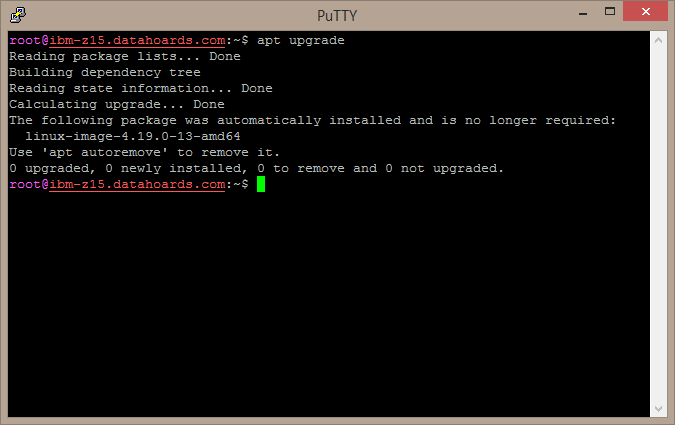
Install the “smartmontools” package
The tool we need (smartctl) is actually just one of several that’s included in a larger suite of tools called “smartmontools“.
To install these tools, the command is “apt install smartmontools”. It may take a couple of minutes for the download/installation to complete depending on your Internet connection and hardware. It should be clear once it has completed, with an output like this:
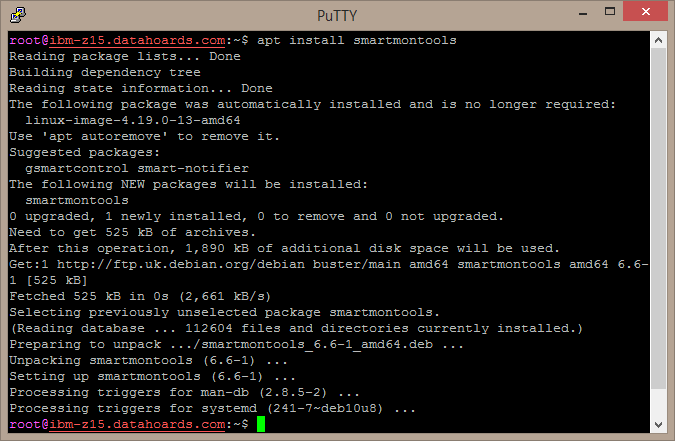
Now that we have the smartctl software installed, it’s all plane sailing. The command to get the current temperature of the drive is “smartctl -A <path to disk> | grep Temperature_Celsius”. As mentioned earlier, my disk has the path /dev/sdb so the command used in the image below is “smartctl -A /dev/sdb | grep Temperature_Celsius”
The smartctl software should run and exit almost immediately, and you should find the output looks similar to the below.

We can see that smartctl is reporting the drive is currently running at 45 degrees Celsius, again, well below the manufacturer’s stated maximum temperature of 60.
What causes a hard drive to overheat?
We’ve seen in the above steps, from comparing our drive’s actual temperature to the manufacturer’s maximum recommended temperature, that our drive isn’t currently running too hot. Let’s imagine, however, that you’ve followed along this far and have found that your drive really is running too hot. For example, the manufacturer’s datasheet for your hard drive lists the operating temperature as 0 – 60 degrees Celsius, and you’ve found your drive is running at 65 degrees Celsius. Let’s explore what could be behind this overheating.
Airflow
We’ll start with the usual suspect. Whenever I’ve come across a drive that’s running too hot, ninety percent of the time, it’s due to airflow, in one way or another. Like many components inside the modern computer system, the hard drive radiates heat through its metal body and this is how it remains cool. If the air surrounding the hard drive is already warm, it makes it much more difficult for this heat radiation or dissipation to take place. It’s for this reason that airflow is so important. Simply put, once a hot hard drive has radiated its heat and made the air around it warmer, this warm air then needs to be moved away, making way for cooler air so that the process can continue.
If you’ve built your own computer, it’s worth checking that there’s adequate physical space around the hard drive and that it hasn’t been squashed up against other components as an afterthought. If this is the case, then try to move the drive to another free drive bay or if that’s not possible, try to move nearby components (expansion cards, etc) further away.
If your PC was pre-built, it’s still worth taking a quick look to make sure the drive isn’t feeling claustrophobic. It may be that additional drives or other components have been added since the system left the factory and airflow might not have been considered by the person performing the upgrade.
Dust is the enemy of airflow so make sure you check that there isn’t a big build-up anywhere in the computer, especially around fans. If you’ve not made any alterations to your system and it wasn’t previously over-heating, then it’s possible the problem is due to dust. If you see a thick layer of dust inside your computer then carefully remove it with a low-powered vacuum cleaner.
Check that all fans are spinning and that their covers and grills are clear from dust. You can usually tell from the sound fans make whether they are struggling with airflow or not.
Failing hardware
Hard drive
It could be that the hard drive itself is beginning to fail, causing it to overheat. It may be that it is physically starting to deteriorate and its motors or bearings are struggling. If the drive is making any unusual clicking, clunking, or grinding noises then it’s safe to assume it’s on its way out.
If there are no audible clues, it’s worth running a SMART test on the drive as it’s often possible to detect a “pre-failure” from a drive’s SMART data.
Power Supply
A failing or low-quality power supply (PSU) can wreak all kinds of havoc on your computer system. The most common symptoms are system freezes and unexpected reboots or blue-screens. An often overlooked symptom of a failing PSU though is over-heating. Sometimes a cheap or failing PSU will keep running but will supply the wrong voltages to the various system components. If a PSU begins supplying too much voltage to a particular component (over-voltage), it often results in that component producing excess heat.
If your PSU is cheap or unbranded, then honestly, I would just replace it regardless. Even if it doesn’t resolve your hard drive over-temperature problem, it’ll save you countless headaches down the road.
If your system already has a decent power supply then it’s worth just checking it over, confirming that the voltages being supplied are correct. To some extent, this can be performed in software by reading various voltage sensors. For a comprehensive check though, you may need to take it to a specialist.
Environment
It’s easy to forget that the environment in which we’re using our computers plays a huge part in keeping their temperature under control. You’ve probably seen that commercial server rooms and datacentres are always environmentally controlled, using air conditioners and the like. This is because no matter how good the airflow and fans inside a computer system are, the hot air they expel needs to go somewhere and the cool air they require needs to come from somewhere!
If your PC is running 24/7 in an unventilated room, without air conditioning, in downtown Bombay, then it’s no surprise that it may suffer from over-heating. Similarly, if you’re using your laptop for hours on end, inside a hot car, it’ll probably struggle to keeps its components cool.
The obvious solution in most cases is to either install proper air-conditioning or to purchase a free-standing air-conditioning unit. There is of course a cost associated with this and A/C systems are out of reach of many amateur data-hoarders.
A cheaper solution is to try to maintain a breeze through the room, possibly with the assistance of electric fans. If you live in a particularly hot environment, it may be that you even need to power off your computer systems during the mid-day heat and only use them at night. I know this isn’t an attractive prospect but it’s better than your hardware becoming damaged and it might provide a stop-gap until proper cooling and ventilation options are on the table.
Summary
If you suspect that your hard drive is too hot, this post should help put your mind at ease. We’ve covered finding your drive’s make and model and checking what its optimum temperature range is. We’ve then looked into the ways of measuring your hard drive’s current temperature so that you know for sure whether it really is too hot or not. Working on the assumption that your drive is too hot, we then explored the various causes of a drive running hot and how we can address these. Having a hard drive overheat isn’t a common issue for most people. If you’re getting into the data-hoarding hobby, however, you’ll likely find you soon have dozens of drives, and overheating is just one of the challenges you may face. It’s all part of the fun though, right?
